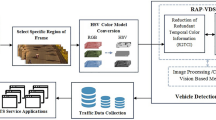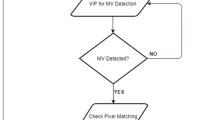Abstract
The increase in day to day vehicular traffic demands an efficient, automated and innovative approach for its management and regulation. One of the most practical and commonly used Intelligent Transportation Systems (ITS) based solution in recent times is video based traffic monitoring. The primary task of such systems is vehicle detection and the existing methods are not robust enough to handle diverse backgrounds and illumination changes in the traffic video. In order to address this issue, a Pre-processing Framework with Virtual Mono-Layered Sequence of Boxes (PF-VMSB) is proposed to make any vehicle detection process robust and efficient. The two composite modules of the proposed system include Effective Element Estimation (E3) module and Dynamic Multilevel Parallel Video Image Processing (D-MPVIP) module. The E3 module enhances the illumination of the traffic video only when necessary to produce an ideal environment for detection. Further, it classifies the type of background in video content (Static, Moderate or Dynamic) to provide an option to choose the appropriate image processing algorithm suitable for vehicle detection. In D-MPVIP module, the redundant video content are eliminated from processing to reduce the computational cost and processing time. Additionally, the spatial color information of the traffic video content is preserved and processed in parallel.The efficiency of the proposed framework of VMSB with E3 and D-MPVIP were analysed using benchmark datasets such as DETRAC, Urban Trackr, Ko-per and self recorded videos. The results shows an overall accuracy of detection rate using conventional image processing techniques such as Background Subtraction (BS) increases by 34.6% and the processing time is reduced by 37.5%. By incorporating the proposed framework into any vehicle detection process, the processing time and computational cost are improved without compromising the detection accuracy. The resultant of the detection process can be utilized by ITS application to enumerate traffic parameters such as vehicle volume count, congestion estimation, speed monitoring, travel time prediction, etc.












Similar content being viewed by others
References
Baf FE, Bouwmans T, Vachon B (2008) Fuzzy integral for moving object detection. IEEE International Conference on Fuzzy Systems, pp 1729–1736
Barnich O, Droogenbroeck MV (2011) Vibe: A Universal Background Subtraction Algorithm for Video Sequences. IEEE Trans Image Process 20(6):1709–1724
Bouwmans T, Garcia-Garcia B (2019) Background subtraction in real applications: challenges. Current Models and Future Directions. eprint 1901.03577
Chen Z, Ellis T (2014) A self-adaptive Gaussian mixture model. SCI Journal on Computer Vision and Image Understanding 122:35–46
Gonzalez RC, Woods RE (2017) Digital image processing, 4th edn. Pearson Publications, New Jersey
Induja C (2018) A survey on vehicle counting - double virtual line. Journal for Research in Applied Science and Engineering Technology 6:4471–4473
KadewTraKuPong P, Bowden R (2002) “An improved adaptive background mixture model for Real-Time tracking with shadow detection. Proc. 2nd European Workshop on Advanced Video-Based Surveillance Systems, pp 135–144
Kamkar S, Safabakhsh R (2016) Vehicle detection, counting and Classification in various conditions. IEEE Journal on IET Intell. Transp. Syst. 10(6):406–413
Kanagamalliga S, Vasuki S, Shanmugapriya M (2016) Foreground object detection using expectation maximization based effective gaussian mixture model. Middle-East J Sci Res 24(Special Issue on Innovations in Information, Embedded and Communication Systems):51–57
Kastrinaki V, Zervakis M, Kalaitzakis K (2016) A survey of video processing techniques for traffic applications. Journal on Image and Vision Computing 21:359–38
Kyungnam TH, Chalidabhongse D, Harwood LD (2005) “Real-time foreground–background segmentation using codebook model”
Liang D, et al. (2015) Co-occurrence probability-based pixel pairs background model for robust object detection in dynamic scenes. Pattern Recogn 48 (4):1374–1390
Manipriya S, Gitakrishnan VV, Reddy B (2015) “Grid-based real time image processing (GRIP) algorithm for heterogeneous traffic,” IEEE International conference on Communication Systems and Networks, IEEE Publications, pp 1–6
Manipriya S, Mala C, Mathew S (2016) “Real Time Multilevel Video Image Processing for VANET,”. In: Proc. 5th international Conference on Computing, Communication and Sensor Network, CCSN
Mohameda A, Issama A, Mohameda B, Abdellatifa B (2015) “Real-Time detection of vehicles using the Haar-Like features and artificial neuron networks”. Elseiver Journal, Procedia Computer Science 73 on Advanced Wireless, Information, and Communication Technologies 73:24–31
Monika (2017) “Parallel processing techniques for high performance image processing applications”, IEEE Publications International Conference on Electrical, Electronics and Computer Science (SCEECS)
Mu K, Hui F, Zhao X (2016) Multiple vehicle detection and tracking in highway traffic surveillance video based on SIFT feature matching. Journal on Information Process System 12(2):183–195
Piccardi M (2004) “Background subtraction techniques: A review”. In: Proceedings of the IEEE International Conference on Systems, Man and Cybernetics, vol. 4, (The Hague, The Netherlands)
Robert PL, Bala R, Trivedi M (2017) “Computer Vision and Imaging in Intelligent Transportation System”, Wiley Publications, vol 1 ISBN: 978-1-118-97160-4
Sankaranarayanan M, Mala C, Mathew S (2014) ‘Performance Analysis of spatial color information for object detection using background subtraction’. Elsevier Publications, IERI Procedia 10:63–69
Seenouvong W, Nuthong K, Ohnishi (2016) Vehicle detection and classification system based on virtual detection zone. International Joint Conference on Computer Science and Software Engineering, pp 1–5
Shah M, Deng JD, Woodford BJ (2014) Video background modeling: recent approaches, issues and our proposed techniques. Springer Journal on Machine Vision and Applications 25:1105–1119
Sivasamy P, Naveen R, Kumari A (2016) “Vision based Vehicle Counting for Traffic Congestion Analysis during Night Time,” Indian Journal of Science and Technology vol 9 issue20
Stauffer C, Grimson WEL (1999) Adaptive background mixture models for real-time tracking. Proc. of CVPR, pp 246–252
Taha M, Zayed HH, Nazmy T, Khalifa M (2017) Day/night Detector for Vehicle Tracking in Traffic Monitoring Systems. International Journal on Computer Electrical Automation Control Information Engineering 10(1):93–99
Yaghoobi Ershadi N, Menéndez JM, Jiménez D (2018) “Robust vehicle detection in different weather conditions: Using MIPM” PLos ONE 13(3): e0191355
Yang S, Xu J, Wang MH (2012) Onboard vehicle detection and tracking using boosted gabor descriptor and sparse representation. IEEE Electronics Letter 48(16):995–997
Zhang Y, Zhao C, He J, Chen A (2016) Vehicles detection in complex urban traffic scenes using Gaussian mixture model with confidence measurement. IEEE Journal on IET Intelligent Transport Systems 10(6):445–452
ZiYangLilian SCP-C (2018) “Vehicle detection in intelligent transportation systems and its applications under varying environments: A review”. Journal on Image and Vision Computing 69:143–154
Zivkovic Z (2004) Improved adaptive gaussian mixture model for background subtraction. International Conference on Pattern Recognition, IEEE Publications 2:28–31
UA-DETRAC Benschmark Suite [Online] Available: https://detrac-db.rit.albany.edu/DetRet
Background Subtraction Library: [Online] Available: https://github.com/andrewssobral/bgslibrary
Author information
Authors and Affiliations
Corresponding author
Additional information
Publisher’s note
Springer Nature remains neutral with regard to jurisdictional claims in published maps and institutional affiliations.
Rights and permissions
About this article
Cite this article
Sankaranarayanan, M., C, M. & Mathew, S. Pre-processing framework with virtual mono-layer sequence of boxes for video based vehicle detection applications. Multimed Tools Appl 80, 1095–1122 (2021). https://doi.org/10.1007/s11042-020-09587-x
Received:
Revised:
Accepted:
Published:
Issue Date:
DOI: https://doi.org/10.1007/s11042-020-09587-x




